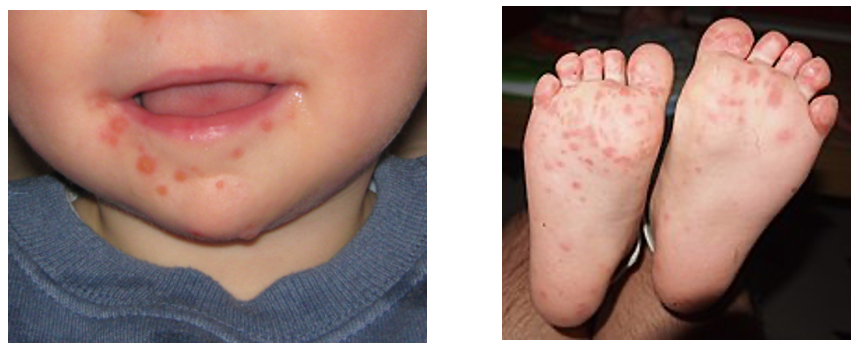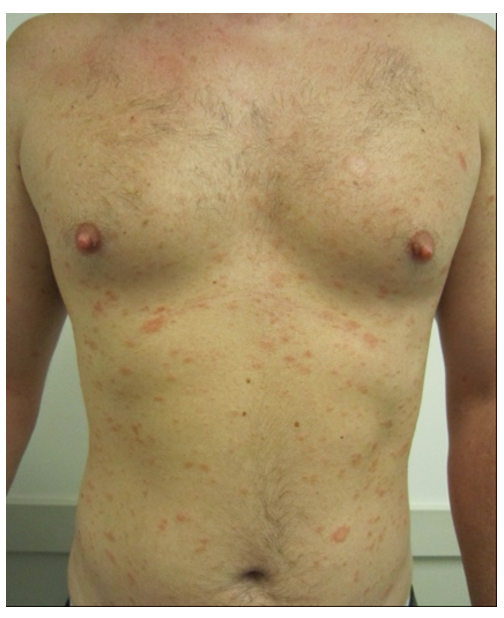Scarlet Fever
This is a systemic reaction to the toxin made by Group A haemolytic streptococci (usually S. pyogenes)
– The infection usually occurs in children around the ages of 3-5 and it is a notifiable disease
– The bacteria can be spread by inhalation of droplets or by direct contact through secretions
– It affects a small number of people who have the strep throat or skin infection (impetigo)
Symptoms:
– General –> fever, malaise, headache, sore throat, swollen lymph nodes
– Strawberry tongue – this initially has a white coating on it, after which red papillae poke through giving it a “strawberry appearance”
– Nausea and vomiting
– Rash – has a punctate (pinhead) erythema with sandpaper texture
– First on torso then spreads to palms and soles (more obvious in flexures)
– Leads to desquamation (scaling off) around the fingers and toes

Complications:
– Otitis media
– Post-streptococcal glomerulonephritis and rheumatic fever
Diagnosis:
– Throat swab can be used to confirm clinical diagnosis
Management:
– Oral penicillin V for 10 days
– Children are excluded from school for 24 hours after they start antibiotic treatment.
Mumps
This is an infection due to the mumps RNA virus that causes bilateral swelling of the parotid glands
– The virus is transmitted by respiratory droplets infecting respiratory tract cells before spreading to the parotid glands and other tissues, leading to market swelling. However, one third of infection are asymptomatic.
– This is a notifiable disease so requires informing public health England
– The disease is now very rare in the UK due to the MMR vaccine.
Symptoms:
– General –> Fever, muscle pain, headache, and malaise
– Parotitis –> facial swelling, earache, face pain (unilateral then bilateral)
Complications:
– Testes (orchitis)
– Pancreas (pancreatitis)
– Aseptic meningitis
– Hearing loss (unilateral)

Diagnosis:
– Can be diagnosed clinically. If uncertain, serological tests for mumps antibodies
Management:
Supportive management as symptoms resolves after 10 days.
Measles
This is a very infectious disease caused by the measles RNA paramyxovirus.
– The virus initially infects epithelial cells in the trachea and bronchi before spreading to local lymph nodes
– It then passes into the blood to infect lung tissue and other organs like the intestines and the brain
– It is spread by droplets, and is infective from the prodrome until 4 days after the rash starts
– It is now a rare disease due to the MMR vaccine, but outbreaks do occur
– It is important to inform public health as it is a notifiable disease
Symptoms:
– Prodrome –> high fever, runny nose, inflamed eyes
– Koplik spots –> white spots (“grains of salt”) on cheek which appear before rash
– Rash –> This starts on the face and spreads to rest of the body (day 3-5)
– It is a maculopapular rash that becomes blotchy and confluent


Complications:
The problem is that the virus can spread to key organs:
– Ears –> gives otitis media (most common complication)
– Brain –> Encephalitis (1-2 weeks after)
– Chest –> Pneumonia (most common cause of death) and myocarditis
– Abdomen –> diarrhoea and increased risk of appendicitis
– CNS –> Subacute sclerosing panencephalitis
– A slow, progressing infection of brain due to measles virus
– Leads to demyelination in adulthood giving upper motor neurons symptoms, similar to multiple sclerosis
Diagnosis:
– Can be made clinically. In uncertain check for serology (IgM antibodies against virus)
Management:
– This is mainly supportive with rest, fluids, analgesia
– If pregnant or immunosuppressed –> admit to hospital
– If a non-immunised child is exposed to someone with measles –> offer MMR within 72hrs
Head lice (Pediculosis capitis)
This is a common condition caused by the parasite Pediculus capitis on human scalp
– Spread by direct head-to-head contact so seen in children who play together
Symptoms:
– Repeated itching and scratching of the scalp
Diagnosis:
– Detection combing of wet or dry hair (wet hair more accurate)
– A live louse must be found to confirm infestation and treat
Management:
– Continue to send children to school and check whole household
– 1st line is Web combing –> if pregnant, breastfeeding, child <2 or asthma
– Chemical insecticide –> Malathion
– Physical insecticides –> Dimeticone, isopropyl myristate or cyclomethicone
Hand, foot, and mouth disease
This is a viral infection seen in children which is caused by intestinal picornaviruses.
– It is usually caused by the viruses coxsackie A16 and enterovirus 71
– It is very contagious and occurs in outbreaks at school
– It is spread by nasopharyngeal secretions and close contact
Symptoms:
– General –> fever, nausea, vomiting, generalised discomfort
– Painful facial ulcers, blisters or lesions around nose and moth
– Flat discoloured spots followed by vesicular sores on palms of hands, soles of feet, buttocks, and the lips
– Rash is rarely itchy for children, but can be for adults

Diagnosis:
– Clinical diagnosis
Management:
– Supportive with fluids and analgesia, self-resolves in about a week
– Children do not need to be excluded from school
Chickenpox
This is an infection seen in children due to the varicella zoster virus
– It usually causes chickenpox in children but then can reactivate from dormancy causing other conditions
– It is spread via the airways and the rash develops 4 days post infection
– The most infectious period is 1-2 days before you get the rash and continues till all lesions are dry
– Whilst it is self-resolving in most children in can lead to complications such as pneumonia and encephalitis.
Symptoms:
– Prodrome of high temperature
– General –> tiredness, headaches, and fever
– Pruritic vesicular rash on head and torso before spreading
– Can lead to secondary bacterial infection of the vesicles
Diagnosis:
– Clinical diagnosis
– If uncertain can do serological testing for antibodies

Management:
– This is supportive treatment to manage the symptoms
– Apply calamine lotion to the vesicles
– If immunocompromised or baby with peripartum exposure –> give varicella zoster immunoglobulin
– School exclusion needed till all lesions are dry and have crusted
Pityriasis rosea
This is a skin rash which is usually seen in the younger population around the ages of 10 to 30.
– It is thought to human herpes virus 7 but is not very contagious
– It has a characteristic feature which is the presence of a herald patch – this is a red and scaly area
Symptoms:
– History of an upper respiratory tract infection
– Prodrome –> headache, arthralgia, fever and tiredness
– Herald patch – this is a red and scaly area which looks like a fungal infection, seen on
the trunk or neck
– This is followed by red, oval spots which appear on the body and arms.
– These follow the skin’s cleavage lines and so gives a “fir-tree” appearance
Diagnosis:
Clinical diagnosis

Management:
Self-limiting condition which resolves on its own
Roseola Infantum (sixth disease)
This is a condition which is caused by the Human herpes virus 6 or 7
– It typically affects very young children below the age of 3, with a peak incidence around the age of 1 years old
– This classically gives a high fever followed by a rash. But the interesting this is that child usually feels well by the time that the rash occurs.
Symptoms:
– Prodrome of high fever –> this lasts for 3-6 days. Despite high fever many children feel well
– High chance of febrile seizures
– Maculopapular rash –> this develops once the fever subsides. It consists of pink raised lesions usually on torso which spread to the extremities
– Can also cause diarrhoea and cough
– Nagayama spots –> Red papules found on the soft palate and uvula
Diagnosis:
– Clinical diagnosis
Management:
– Self-limiting illness which resolves on its own


